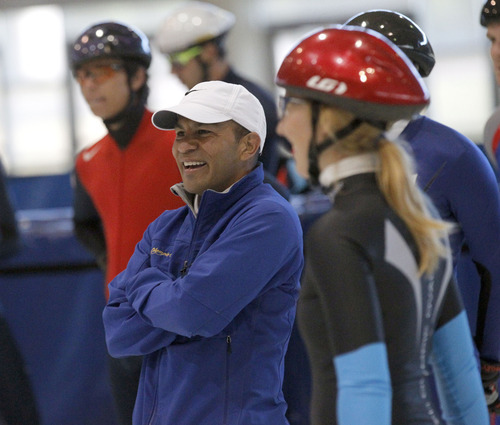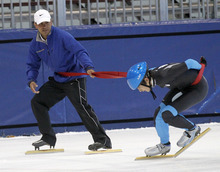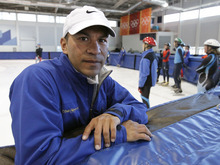This is an archived article that was published on sltrib.com in 2012, and information in the article may be outdated. It is provided only for personal research purposes and may not be reprinted.
Kearns • As the ice clears after a workout at the Olympic Oval, two figures still circle the ice.
The man, 42, pulls firmly on a red fabric belt, crossing his legs with slow, exaggerated emphasis. The boy, 14, follows along, lassoed for simulated force as they make the turn.
Step firmly. Keep your hips square. Don't waste energy.
Ten years ago, this was where Derek Parra picked up silver and gold medals in speedskating, where his father finally saw him on the ice for the first time and burst into tears. Today, it's where he looks after the next generation of U.S. speedskaters.
His goal? To give young skaters the support he never had.
Now the Utah Olympic Legacy Foundation's outreach youth programs director, Parra first found his beloved sport because he was, well, thirsty.
As a 14-year-old in San Bernardino, Calif., he followed his older brother to the local roller rink. His father, a corrections officer, had given him $4. Admission and skate rental cost $3.75. After using his last quarter on a video game — he lost quickly — Parra had nothing left for food and drink.
But at every evening session, the DJ would shut down the music and flip on the white fluorescent lights. Every age group got a shot at a two-lap race. A free drink dangling before him as the reward, Parra took a chance with his banged-up quad skates.
He lost, but fell in love.
"I had fun doing it," he says. "It was the first time in my life I remember going like, 'Wow, I just got my butt kicked, but that was fun.' "
Parra soon joined the rink's in-line speedskating team. Three years later, after he saved up money for better skates, he graduated high school early and bought a one-way ticket to Florida. No one in his family understood his dream, so he sought out Virgil Dooley — whom he'd met at a summer training camp — for help.
With Dooley's coaching, the 5-foot-4 skater quickly ascended the sport's ranks. By the time he was 26, he had become one of the most decorated athletes in in-line speedskating, hauling in five golds, two silvers and a bronze at the 1995 Pan-American Games.
What he didn't have was a shot at the Olympics, something he could find only on ice. So Parra soon swapped in his wheels for blades and began crossing over, unlearning the years of habits he had accumulated. He compares racing on wheels to pushing a broom in short chops. On ice, racing feels more like sweeping.
He wasn't satisfied with his technique until the 2002 Olympics.
Parra was one of the first to make the jump from in-line, but it's a process that's now commonplace. Part of his work after his racing career was to smooth the process. When he first tried ice skating, he says, getting help was like "pulling teeth." Now, with a stronger support network, the transition can be compressed into as little as two years instead of six.
But he's careful to maintain the philosophy of "sport for life" — making sure not to overwork kids either physically or mentally. Beneath the training grind, there must be a current of love for the work.
"Now that I'm working with the youth, [I get] to see a kid be happy just because they crossed over [on a turn]," Parra says. "I think these guys, the upper levels, forget about it sometimes because we're searching for that tenth of a percent that's hopefully gonna help you medal."
The Oval looks a little different now. There are fewer seats. There are more banners. But still the same is the spirit of Olympics that first pulled Parra to Salt Lake City.
"When you're tired, you're fatigued, you're upset, you're having a bad day — think about what you're doing," he says. "It's amazing." —
About Derek Parra
Derek Parra won gold and silver speedskating medals in the 2002 Olympics.
His big moment in Salt Lake City was preceded by a successful in-line career.
He now helps young skaters train at the Olympic Oval.







